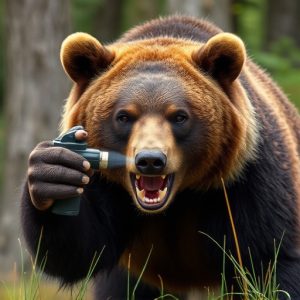Bear Spray Fog Pattern Test: Efficacy & Safety Measures for Charging Bears
The Bear Spray Fog Pattern Test is a crucial evaluation method for understanding bear spray effectiv…….
The Bear Spray Fog Pattern Test is a crucial evaluation method for understanding bear spray effectiveness in real-world scenarios. By simulating encounters, it measures range, density, and longevity of the spray's fog pattern, providing insights into performance. Researchers analyze these patterns to determine optimal application distances and identify weaknesses, ensuring responsible use during bear interactions. For safety when facing charging bears, aim for the face and eyes within 20-30 feet, stay calm, choose FDA-approved spray with at least 2% capsaicin, and signal for help—using bear spray as a last resort.
“Unraveling the power of bear spray, a vital tool in wildlife encounters, especially when facing aggressive bears. This comprehensive guide explores the science behind the spray’s effectiveness, with a key focus on the Bear Spray Fog Pattern Test. We delve into how this test assesses its range and impact against charging bears, ensuring users are equipped with knowledge for safe outdoor adventures. Furthermore, discover the real-world efficacy of bear spray and learn essential safety measures for responsible usage.”
- Understanding Bear Spray Fog Pattern Test
- Efficacy of Bear Spray Against Charging Bears
- Safety Measures and Best Practices for Using Bear Spray
Understanding Bear Spray Fog Pattern Test
Understanding the Bear Spray Fog Pattern Test is crucial when assessing its effectiveness against charging bears. This test simulates real-world scenarios by measuring the spray’s range, density, and longevity in a controlled environment. It involves releasing a specific amount of bear spray into the air to create a fog pattern, allowing researchers to analyze how well the spray covers the bear’s path and deters it from advancing.
The Bear Spray Fog Pattern Test provides valuable insights into the spray’s performance. By observing the fog’s dispersion, one can determine the optimal distance for application during a bear encounter. This test also helps in identifying potential weaknesses, such as areas where the spray may not be dense enough to stop an aggressive bear in its tracks. Ensuring proper understanding of these patterns is key to using bear spray effectively and responsibly.
Efficacy of Bear Spray Against Charging Bears
Bear spray has long been touted as an effective deterrent against aggressive bears, but its true efficacy is only fully understood through rigorous testing. One such test involves examining the bear spray fog pattern to assess its range and coverage. This pattern reveals how far the spray can reach and how well it coats an area, which are crucial factors in deterring a charging bear.
The Bear Spray Fog Pattern Test provides valuable insights into the performance of different types of bear spray. It measures the spray’s distribution, ensuring that it not only reaches the bear but also creates a barrier that disrupts its path. This test is essential for outdoor enthusiasts and those living in bear country to make informed decisions about their safety. By understanding the fog pattern, individuals can choose the most effective bear spray and employ proper application techniques to maximize protection when encountering an aggressive bear.
Safety Measures and Best Practices for Using Bear Spray
When it comes to encountering charging bears, having bear spray on hand is a crucial safety measure. However, understanding how to use it effectively is just as important as having it. The optimal application involves aiming for the bear’s face and eyes, as this disrupts their sense of smell and vision, temporarily halting their charge. It’s essential to remember that bear spray creates a fog pattern, so staying calm and ensuring you’re within the recommended range (typically 20-30 feet) is vital for successful deployment.
Best practices include practicing with the spray beforehand, familiarizing yourself with its range and effect, and storing it in an accessible yet secure location. Always ensure your spray is FDA-approved and contains a minimum of 2% capsaicin, the active ingredient that deters bears. During an encounter, remain stationary, make yourself appear larger, and use hand signals to communicate. Only use bear spray as a last resort when a bear charges or shows aggressive behavior.
In conclusion, bear spray has proven to be an effective deterrent against charging bears, as demonstrated by the Bear Spray Fog Pattern Test. When used properly, it can create a protective barrier, allowing for safe escape or de-escalation of potentially dangerous encounters. However, understanding the spray’s fog pattern and adhering to safety measures is crucial for maximizing its efficacy. By following best practices outlined in this article, individuals in bear country can better protect themselves and reduce the risk of aggressive bear interactions.


